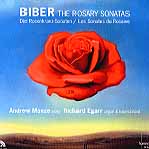Dare I say that this must be Andrew Manze’s best disc so far? In a catalog that includes his unsurpassed, standard-setting performances of sonatas by Tartini, Rebel, Uccellini, Telemann, Bach, and Corelli–not to mention other sonatas by Biber, this one is impressive not only for the by-now expected technical virtuosity, stylistic facility, and the perfectly in-sync partnership of Manze and Richard Egarr, but also–and perhaps most remarkably–for the sound of Manze’s violin. Biber wrote these 15 sonatas employing scordatura (or alternate tuning), thus assigning unique sonic characteristics to each of the 15 sacred “mysteries”. Sometimes the differences are subtle, in other cases they are more dramatic, and they are realized here like never before.
This is achieved by Manze’s decision to use a single violin for all the sonatas, retuning it as required with “one set of equal-tension strings, made of sheep gut, without any metal covering.” As a result, we can hear to striking effect the differences in the violin’s voice and character as it changes according to the composer’s concept of each sonata. By adding more or less tension to the strings, by reconfiguring the usual intervallic relationships between one string and its neighbor and thus creating a whole series of different resonating effects, a violin can be sweetly alluring one minute and coldly hard-edged the next. In between these sounds is an array of timbres and voices uncommonly heard (as we do here) coming from four strings and a wooden box–albeit, in this case, an Amati wooden box.
Violinists who tackle the considerable difficulties of Biber’s formidable lines and sometimes extreme alternate tunings often use a set of pre-tuned instruments–but Manze’s approach makes for a far more dramatic listening experience as we realize this one violin’s transformation from the Five Joyful Mysteries (Annunciation, Nativity, etc.) to the Five Sorrowful Mysteries (Crucifixion and Death), and ending with the Five Glorious Mysteries (Resurrection, Ascension, Assumption of Mary, etc.). But as Manze points out in his relatively brief but very helpful notes, we should not become distracted in these works with attempts to identify strict programmatic effects that Biber may or may not have intended. Rather, to fully appreciate these complex yet eminently listenable and highly appealing sonatas, we should take a more contextual approach, for example “seeing” the picture of Christ on the cross rather than trying to hear the sound of the hammering of nails.
Of course, you can’t help but be totally engrossed in Manze’s playing, which is so free of artifice and effort that it leaves us free to revel in and wonder at the sheer range of expression he achieves in this monumental tour de force–arguably the most challenging two hours of music in the violin repertoire. And the engineering is so true to the music’s purpose and to the instrument’s tonal characteristics that we don’t even have to try to hear–and feel–the effects of Biber’s ingenious “mistunings”. It helps that the performers chose to use only one accompanying instrument (Egarr switches between organ and harpsichord) so, as Manze suggests, to be faithful to the music’s original purpose, evoking “an intimate, private atmosphere suitable for prayer and meditation.”
The opening bars of the Praeludium to the first sonata (The Annunciation) are breathtaking–the violin seems to be emerging from another world, and Manze holds us spellbound, suspended for the next two minutes in awed anticipation, quickly satisfied by the gorgeous, spinning flourishes and richly sonorous double-stops of the following Aria, and ending in a series of strange, short, improvisatory utterances. The next two hours are full of enough technical feats and interpretive artistry–both grand and almost imperceptibly subtle–to keep violin aficionados enthralled for a very long time. How Manze does it is another mystery we can add to the 15 he performs here.
[Note: For those interested in knowing more, the program concludes with a discussion/demonstration by Manze titled “Scordatura briefly explained.”] [8/16/2004]
































